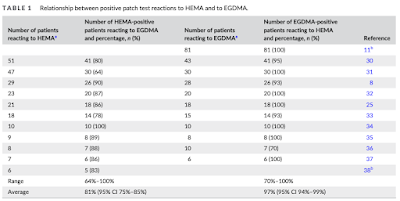REVIEW
Free Access
Anton C. de Groot, Thomas Rustemeyer
Abstract
This is the second part of a literature review of the clinical aspects of contact allergy to and allergic contact dermatitis from 2-hydroxyethyl methacrylate (HEMA). Topics include cross- and co-sensitization, atypical manifestations of contact allergy, frequency of positive patch tests to HEMA compared with other (meth)acrylates, sensitivity of HEMA as a screening agent, the presence of HEMA in commercial products, and practical information on patch testing procedures. Primary sensitization to methacrylates including HEMA may result in methacrylate and acrylate cross-sensitization. There is a strong cross-allergy between HEMA, ethylene glycol dimethacrylate (EGDMA), and hydroxypropyl methacrylate; many reactions to EGDMA are cross-reactions to primary HEMA sensitization. Rare atypical manifestations of HEMA-allergy include lichen planus, lymphomatoid papulosis, systemic contact dermatitis, leukoderma after positive patch tests, and systemic side effects such as nausea, diarrhoea, malaise, and palpitations. The occurrence of respiratory disease caused by methacrylates such as asthma is not infrequent. HEMA is the most frequently patch test-positive methacrylate. It is a good screening agent for allergy to other (meth)acrylates. Patch test sensitization to HEMA 2% pet. is extremely rare. There are (some) indications that HEMA is frequently used in dental products and nail cosmetics.


No comments:
Post a Comment